Salford, Lancashire
Up to 1834
In 1793, Salford opened a workhouse at the junction of Collier Street and what is now Trinity Way in the Greengate district, just across the Irwell from the centre of Manchester. This establishment, once described as "a very handsome building", continued in use until the new Salford union workhouse was erected in 1853.
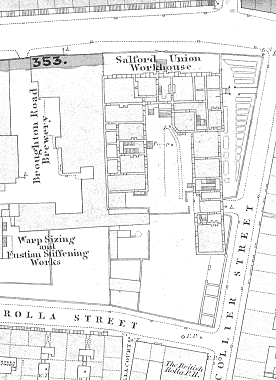
Salford Greengate workhouse site, 1848.
After demolition of the workhouse, the Collier Street public baths were erected on the site. (The baths were designed by Thomas Worthington who, coincidentally, designed the ground-breaking infirmary at Chorlton workhouse.) At the time of writing, this fine building was standing derelict.
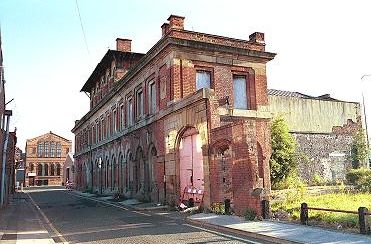
Salford Collier Street baths from the north, 2000.
© Peter Higginbotham.
A parliamentary report of 1777 recorded a workhouse in operation at Pendleton for up to 28 inmates. It was located on the east side of what is now Broughton Road. It was After 1834, this became used as a Union school.
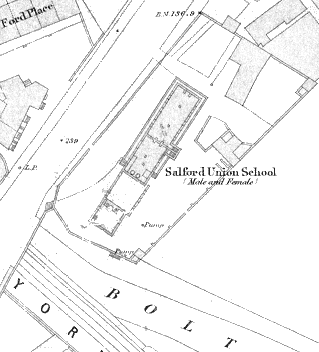
Salford Pendleton workhouse school site, 1848.
After 1834
The edicts of the new Poor Law of 1834 met with considerable opposition in many northern manufacturing areas, both from the workers who had failed to gain the vote under the 1832 Reform Bill, and also from the rate-payers who would have to finance the system. Salford, in fact, became a centre of resistance and a Salford Anti Poor Law Movement was formed, led by the Chartist, RJ Richardson.
The Salford Poor Law Union finally received its official declaration from 12th July 1838. Even after the Union was formed, its 18-strong Board of Guardians representing the four constituent parishes of Salford, Broughton, Pendlebury and Pendleton, refused to co-operate with the Poor Law Commissioners and operate the new law as prescribed. The old and inadequate buildings at Greengate and Pendleton continued in use until a new Union workhouse finally opened in 1853. Greengate appears then to have been closed down, and Pendleton used to accommodate the elderly.
The New Road Workhouse
The new Union workhouse was erected at a cost of £16,500 in 1851-53 to the south-west of Salford, sandwiched between Eccles New Road and the Manchester to Liverpool railway. Designed by Messrs Pennington and Jarvis it was intended to accommodate 300 inmates. A contemporary report described it as follows:
The location and layout of the new workhouse is shown on the 1888 map below:
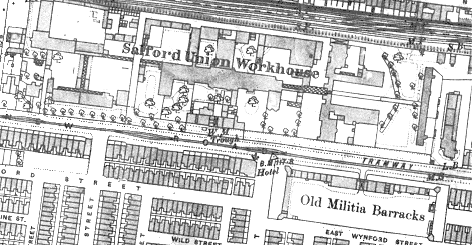
Salford Union workhouse site at New Eccles Road, 1888.
The main entrance to the workhouse was at the centre where the porter's lodge and offices faced onto the street. To the rear, were clothes stores, food stores, kitchen and dining hall. Men were accommodated at the west of the workhouse and women at the east. On the men's side, the old and infirm were placed at the south nearest to the road. The able-bodied were housed to the rear where there were workshops, stone cells, piggeries and a bakehouse. On the women's side were a wash house and laundry as well as the Master's house and garden. Further to the east were blocks for old and infirm women and a probationary ward for children. Casual wards lay at the far eastern end together with a row of stone-breaking cells. There was also a covered labour-test shed where men not resident in the workhouse worked during the day in return for food and a small amount of money.
A detailed plan of the workhouse is shown below (click on the image for a larger version):

Salford workhouse plan
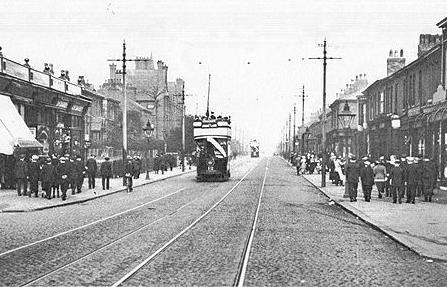
Salford Union workhouse (left of centre) from the west.
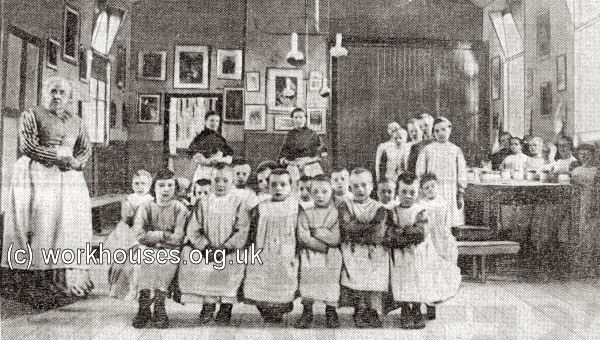
Salford workhouse children, 1890s.
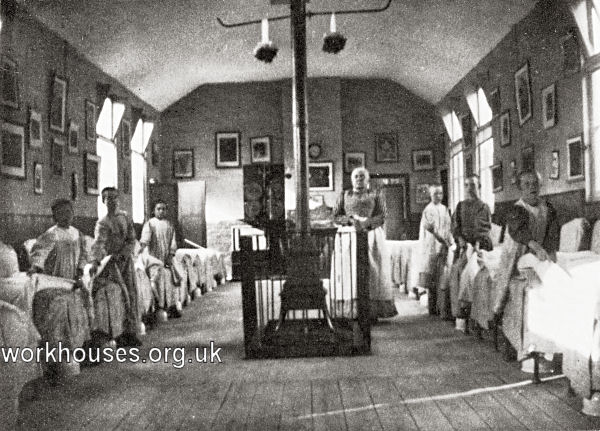
Salford workhouse boys' dormitory, 1890s.
In April 1880, new casual wards were opened which adopted the then new "cellular" design, as reported in the Local Government Chronicle:
New casual wards, on the cellular system, have been opened this week at the above union workhouse, from designs by Mr. H. Pinchbeck, King-street, Manchester. These wards are the fourth built on the cellular system, and are each fitted with a wood bed, well lighted and ventilated. The doors are strong, and secured with a double lock on the outside. Food doors are inserted, and inspection slides, which enable the attendant to see every portion of the cell without opening the door. To each is fixed a label apparatus, and by turning a handle from the inside a label is thrown out, and the gong placed in the corridor of the administrative department is struck, calling the attention of the attendant, and indicating the cell where he is required. On one side of the building, running the full length, are three rooms, in which mills will be placed for grinding corn, with connecting rods and handles fixed inside the cells, which the vagrants will have to turn and grind a given quantity of corn before leaving the building. On the first floor are the women's cells, eighteen in number, seven being double, for women with children, approached by a wide flight of stone steps, with waiting, bath, and storerooms, and fitted in every respect like the male wards. All the cells throughout are lighted by windows and by gas brackets made purposely, fixed in the corridor, apertures being left in the walls, covered with fine wire, through which the gaslight is admitted. All the cell windows have been designed to open and close simultaneously from the corridor by the attend ant, and under his control only. All the floors, except in the administrative department, are laid with cement concrete. Great care has been taken in thoroughly ventilating the cells and other parts of the building, and the whole building is heated by hot water. The contract price for the whole of the works being £4,840. The building stands on a sloping site, and advantage is taken of this to arrange the basement above the outside ground line. This contains heating cellar, coal cellar, stone rooms, cooking kitchen, disinfecting room, and three work-rooms under the cells, each 45 feet long and 24 feet wide. There are three entrances, that in the centre being for the attendant in charge of the building. The entrance on the left is for male and that on the right for female vagrants. The male vagrants enter a spacious corridor, and pass into a waiting-room 21 feet long and 14 feet wide, thence to the bath-rooms, which are directly opposite. There are two, each containing two baths, and fitted with wash-basins, supplied with hot and cold water. Adjoining the waiting-rooms and opposite the bath-room is a large store-room, where rugs and clothing will be kept. On leaving the bath-rooms, the vagrants pass into the cells. There are 36 for males, which are arranged on each side of a corridor 125 feet in length. The building has been designed with a certain degree of taste. The front and side elevations of the administrative department are faced with bright red stocks, relieved with ornamental bands, and the doors, windows, and porches have stone dressings.
From 1904, to avoid possible future stigma, the birth certificates of those born at the workhouse recorded the location simply as 92 Eccles New Road. In around 1919, the same practice was adopted for the death certificates of deceased inmates.
The tramp wards had closed by 1920. During the 1920s, a number of plans were discussed to close the workhouse wither convert it to flats or to build new housing on the site. However, it remained in use until the abolition of the Board of Guardians in 1930. It was then demolished and replaced by the three-storey flats of the Langworthy Estate, a large-scale rehousing project, which was officially opened in 1938.
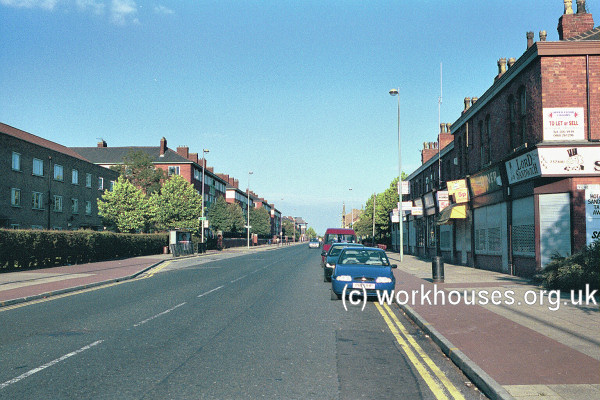
Salford workhouse site location from the west, 2000.
© Peter Higginbotham.
Union Infirmary / Hope Hospital
As well as the workhouse, the Union erected a poor-law infirmary for 880 patients at the south side of Eccles Old Road at Hope. Built in 1880-82 at a total cost of £64,000 to designs by Lawrence Booth.
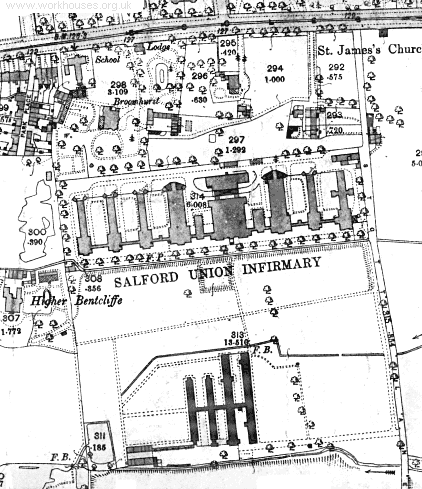
Salford Union infirmary site, 1888.
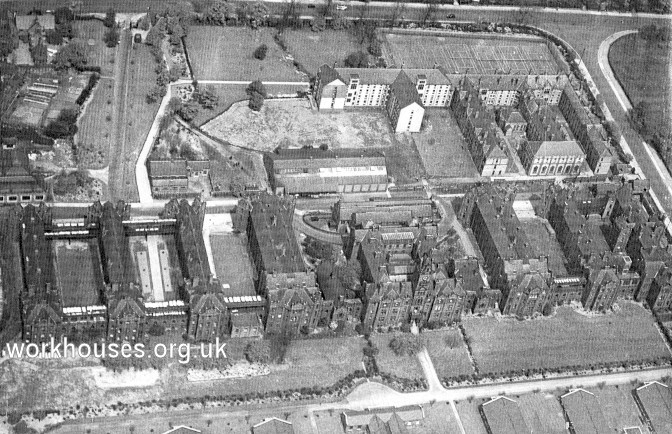
Salford Hope Hospital from the south, 1940s.
An entrance lodge lay on Eccles Old Road at the north of the site.
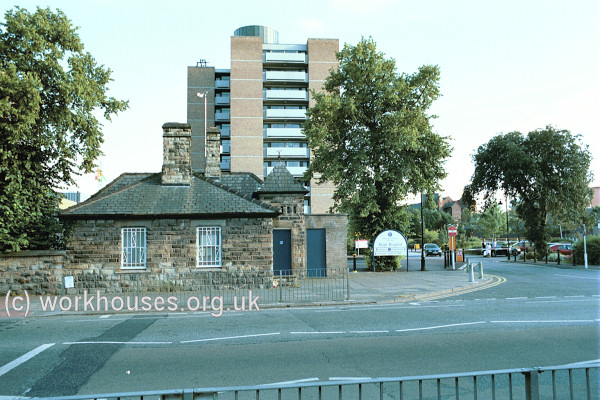
Salford Hope Hospital north entrance lodge, 2000.
© Peter Higginbotham.
Three-storey ward blocks were arranged either side of a central administrative building. They were linked by a covered way at the south, and by open balconies on the upper floors at the north which also served as fire escapes.
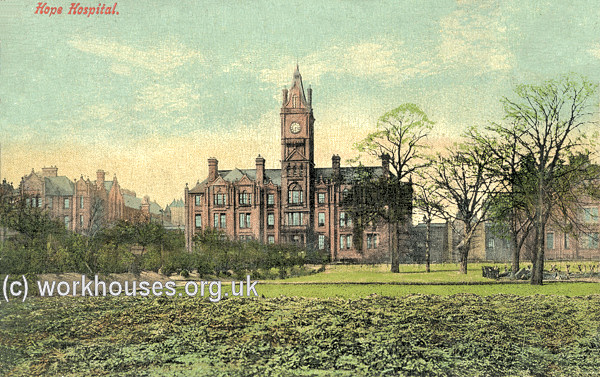
Salford Hope Hospital from the south, early 1900s.
© Peter Higginbotham.
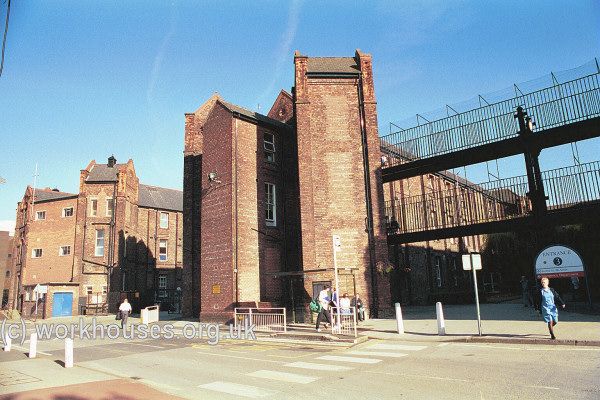
Salford Hope Hospital ward blocks from the north-west, 2000.
© Peter Higginbotham.
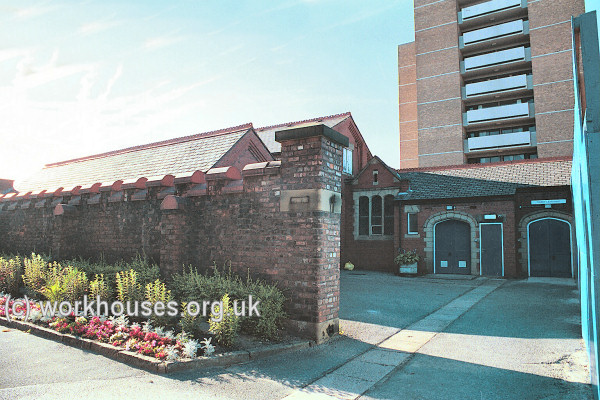
Salford Hope Hospital , 2000.
© Peter Higginbotham.
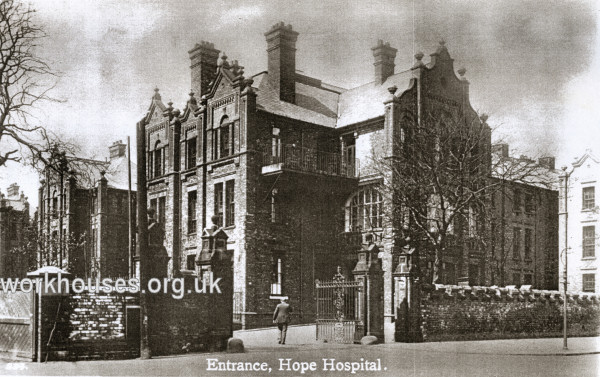
Salford Hope Hospital eastern entrance, early 1900s.
© Peter Higginbotham.
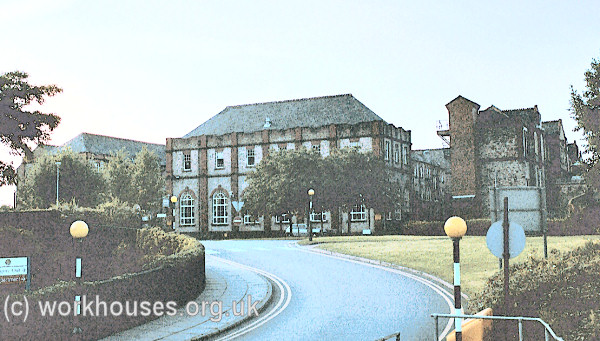
Salford Hope Hospital entrance drive, 2000.
© Peter Higginbotham.
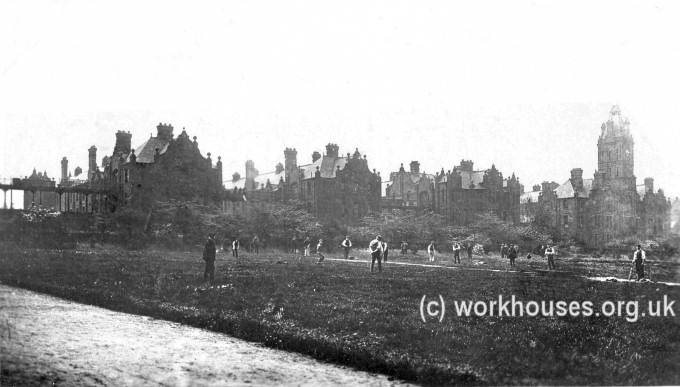
Salford Hope Hospital - cricket game in progress, early 1900s.
© Peter Higginbotham.
Salford Old People's Homes
On 10th December, 1924, the Chairman of the Guardians laid the foundation stone for a large pavilion-plan complex of old people's homes on a nine-acre site at the south of the union infirmary. The buildings, all at ground-floor level, were planned to accommodate up to 250 men and 250 women. The design of the homes was opened to a limited competition for a selected number of Manchester architects, with the winning design being submitted by Charles Swain. The cost of construction was in the region of £66,000.
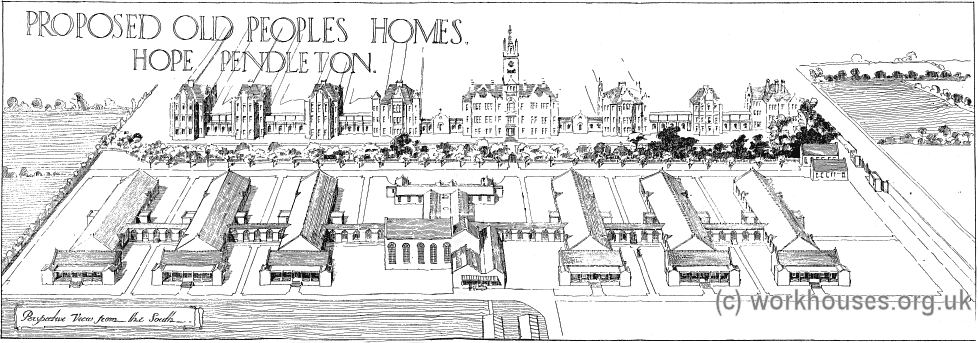
Architects's design for Salford old people's home, 1924.
© Peter Higginbotham.
The buildings, all linked by a connecting corridor, comprised:
- Three pavilions for men at the east.
- Three pavilions for women at the west.
- A central administrative block containing kitchens, stores, offices and apartments for staff, and a large dining-hall. The dining-hall had separate entrances for males and females and was arranged "so as to permit also of uses for entertainments etc.".
- A porter's lodge at the east side, near to Stott Lane, with receiving wards for both the homes and the union infirmary.
Each pavilion contained three large wards at the north side and four at the south. The large wards were separated from one another by collapsible glazed screens which, when folded up, produced a single room forty feet across. At the south side of the homes, each pavilion had a verandah.
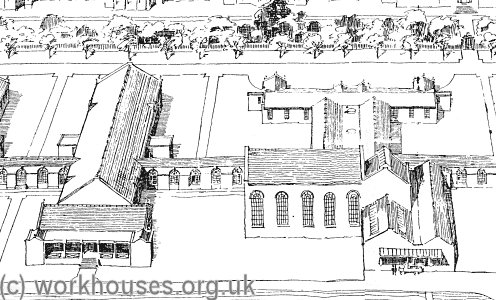
Salford old people's homes women's pavilion and administrative block from the south, 1924.
© Peter Higginbotham.
Later known as The Homestead, the old people's blocks no longer exist.
Culcheth Cottage Homes
In 1903, Salford Union erected a cottage home complex on a semi-rural site at Culcheth. Pauper children were housed in groups of around 30 under the supervision of a house-father or house-mother. The site included 13 houses, together with a school, workshops, an infirmary, a swimming bath and a superintendent's house. The site layout is shown on the 1905 map below:
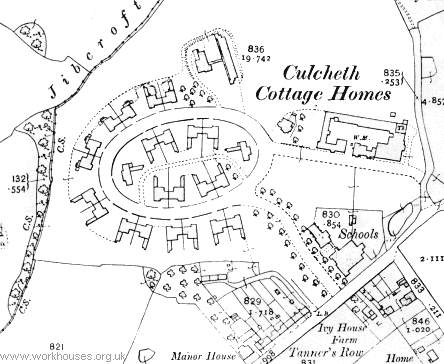
Salford Culcheth Homes site, 1905.
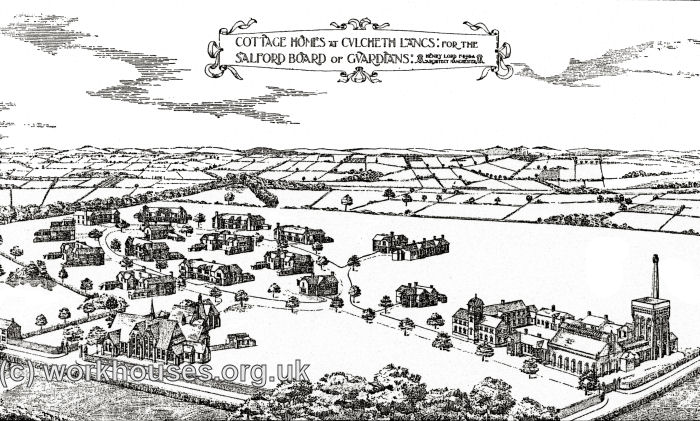
Culcheth cottage homes from the south-east, 2001.
© Peter Higginbotham.
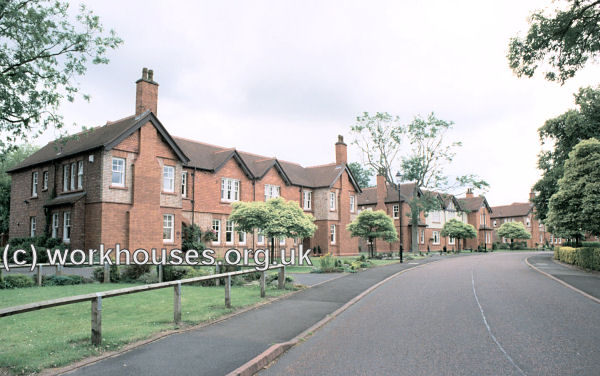
Culcheth cottage homes from the east, 2001.
© Peter Higginbotham.
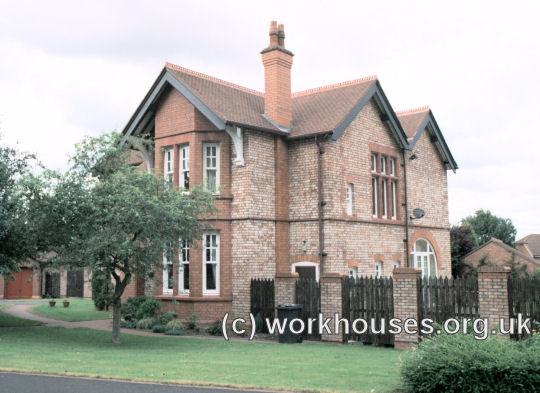
Culcheth cottage homes superintendent's house from the south, 2001.
© Peter Higginbotham.
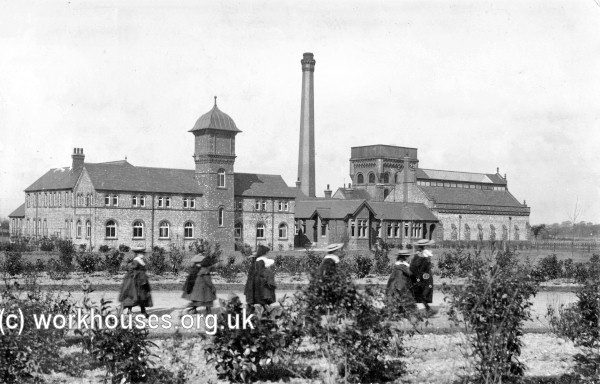
Culcheth cottage homes workshops and baths from the south-west, c.1905.
© Peter Higginbotham.
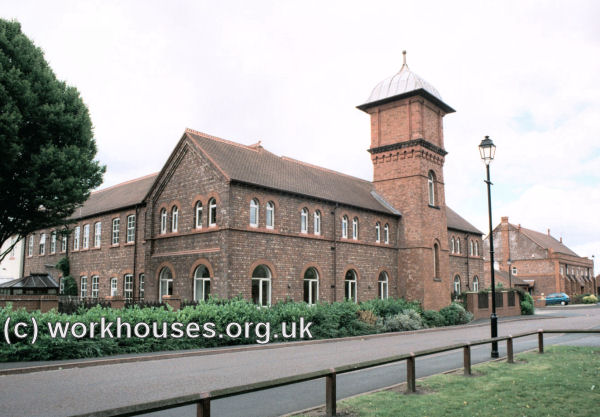
Culcheth cottage homes workshop yard buildings, 2001.
© Peter Higginbotham.
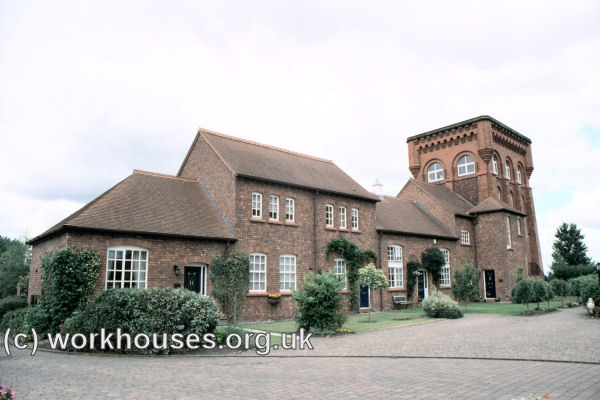
Culcheth workshop workshop yard buildings, 2001.
© Peter Higginbotham.
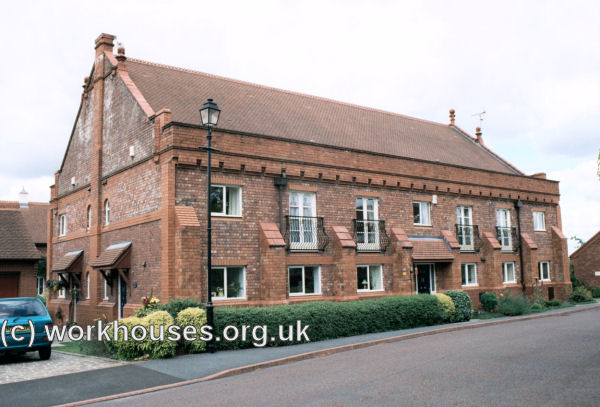
Culcheth Culcheth swimming-bath block, 2001.
© Peter Higginbotham.
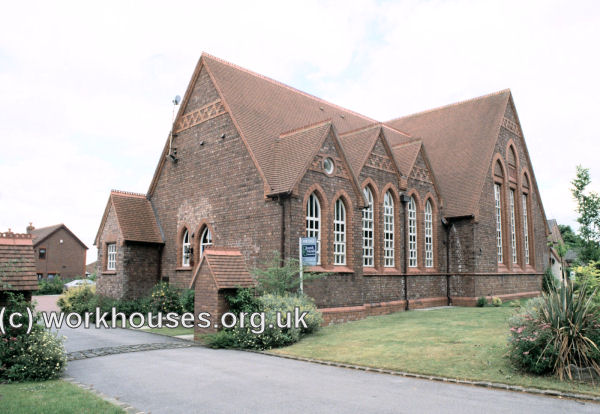
Culcheth southern school block from the west, 2001.
© Peter Higginbotham.
According to Plant (1928):
The cottages accommodate 12-14 children each and there is a hospital in wards to accommodate 32 patients. The staff and children attend at the Parish Church each Sunday at 10:30am and the Rector is chaplain of the Homes. The children attend school until the age of fourteen. The buildings and the classroom in particular are planned on a generous scale and are liberally equipped.
When a child has passed its fourteenth birthday, it leaves school, and while remaining in the Colony spends its school-hours in one or other of the industrial shops, each of which is under the control of an experienced tradesman or tradeswoman, and where it receives careful tuition and acquires practical knowledge.
Boys have a choice of the Shoemaker's Shop, in which all boot repairs are executed, and a large proportion of new work is undertaken: the Joiner's Shop, in which all renewals of and repairs to woodwork for the Homes are made; the Bakehouse which supplies the Colony with all its bread and cake; the Plumber's and Engineer's Shop, which provides the Colony with electric light and the water and heat; the Painter's Shop, which is responsible for all decoration and re-glazing in the Colony. Gardening is taught to both boys and girls. In addition every boy has the opportunity of joining the Brass Band
These numerous centres of activity, together with the large mixed farm, makes the Colony practically self-contained, and it is a rare occurrence to see any outside tradesmen at work on the grounds. The value of the training is shown when the children leave the Homes and almost without exception they do well and make headway.
The homes closed in 1936. After the Second World War, the site became Newchurch Hospital, providing care for the mentally handicapped until the 1970s.
The former cottage homes have now been converted to residential use.
Staff
Inmates
- Long-term workhouse inmates (1861)
- New Eccles Road workhouse, 1881 Census
- Pendleton workhouse, 1881 Census
Records
Note: many repositories impose a closure period of up to 100 years for records identifying individuals. Before travelling a long distance, always check that the records you want to consult will be available.
- Salford City Archives, Salford Museum and Art Gallery, Peel Park, The Crescent, Salford M5 4WU. Admissions and discharges registers were pulped during WW2. Surviving records include Guardians' minute books (1838-1930); Workhouse visiting committee minutes (1865-1930); etc.
Bibliography
- Salford: A City and Its Past edited by Tom Bergin, Dorothy N Pearce, Stanley Shaw (1989)
- Plant, O.R. (1928) A History of Newchurch Parish
Links
- None.
Unless otherwise indicated, this page () is copyright Peter Higginbotham. Contents may not be reproduced without permission.


